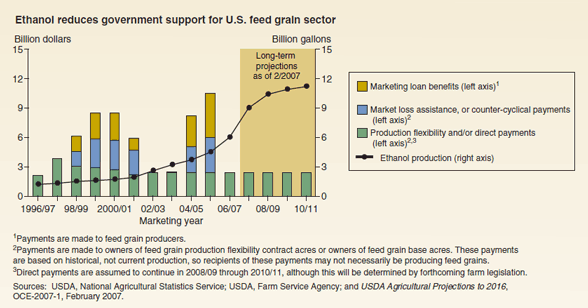Ethanol Reduces Government Support for U.S. Feed Grain Sector
Warning: Undefined variable $tagger in /var/www/bioenergypro.com/public_html/bioenergy-articles/snews.php on line 2924
Warning: Undefined array key "https://www.bioenergypro.com/bioenergy-articles/Logged_In" in /var/www/bioenergypro.com/public_html/bioenergy-articles/snews.php on line 2999
The surge in the use of corn in ethanol production is increasing the price of corn received by producers, thereby reducing the income support received by the Nation’s feed grain sector.
In the past decade, a large share of farm support has come from income support programs, such as marketing loan benefits, market loss assistance or counter-cyclical payments, and production flexibility or direct payments. Now, however, market revenue, stimulated in part from renewable energy policies and strong energy prices, is increasing in importance to the sector.
Ethanol demand for corn is raising feed grain prices above farm program support levels, thereby reducing or eliminating marketing loan benefits and counter-cyclical payments. For example, the season average price received for corn was $2 per bushel in marketing year 2005, but the projected price for marketing year 2006 is $3.20 per bushel, as of March 2007. In the 2005 marketing year, income support for feed grains totaled $10.5 billion, coming from marketing loan benefits, counter-cyclical payments, and direct payments. In marketing year 2006 and the next several years, stronger prices are expected to reduce income support to include only direct payments.
The size and speed of the increase in corn’s use in ethanol production is unprecedented in its effect on the U.S. feed grain market and its implications for other agricultural markets. Nonetheless, there are risks in the ethanol market outlook. Ethanol production is expected to continue to grow and exert pressure on the agriculture sector but its growth rate depends on several factors, including oil prices, ethanol prices, feedstock costs, changes in technology, and changes in government incentives and policies. The use of corn in ethanol production could also decline for several reasons, and thereby mitigate pressure on the agriculture sector. For example, crude oil prices (gasoline prices) could decline, feedstock costs could rise further, ethanol’s price premium to gasoline could disappear, or technological breakthroughs could lower alternative feedstock costs to compete with corn.

by
Linwood Hoffman - USDA
This article hasn't been commented yet.


Write a comment
* = required field